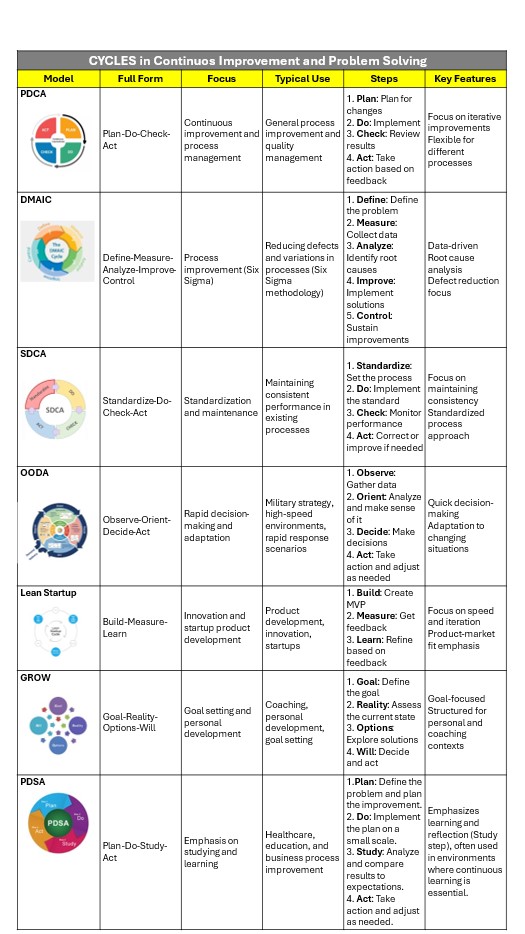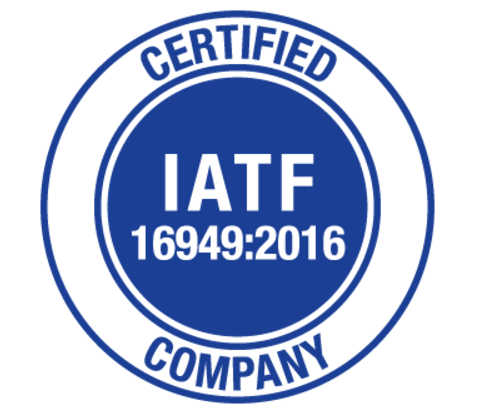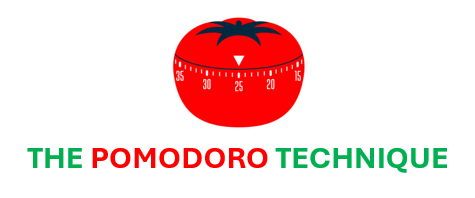Cycles in Continuous Improvement and Problem Solving
Beyond the well-known PDCA and DMAIC methods, in this post, I would like to introduce some less known cycles that can be highly useful when thinking about process improvement, product development, problem solving or even personal growth.
I gave this post the title “cycles” because each method can be outlined as a cycle, and its components together form an interconnected system. Another characteristic of the cycle is that it doesn’t end—it is not a static, but a dynamic system. It is a living system that must be continuously maintained and nurtured, as this is the only way it can lead us to the desired level of development or solve a problem.
SDCA (Standardize-Do-Check-Act)
SDCA can be used on its own, but if used alternately and continuously with PDCA, it leads to greater effectiveness. While PDCA is used for process improvement, SDCA is used for standardization.
SDCA emphasizes standardizing processes before starting improvements. It is often used for maintaining existing processes and ensuring consistent performance before proceeding with changes.
Steps of SDCA:
1.Standardize: This step means defining and setting clear standards or processes that everyone has to follow. The goal is to ensure that the baseline for operations is established, making work predictable and consistent. These standards are often created based on best practices or lessons learnt.
- Do: Once the standards are set, we move on to executing or implementing them. This is the phase where we actively follow the defined processes and try to maintain consistent work.
- Check: After performing the standardized process, we monitor and check the results. This step typically involves evaluating whether the standards are being followed properly and whether the desired results are being achieved. It’s a key stage for identifying any deviations and areas that might require attention.
- Act: Based on the results from the “Check” phase, adjustments or improvements are made. If something is not working well, we take corrective actions to either modify the process or fix any underlying issues to improve performance.

Benefits of using SDCA:
- Consistency: By standardizing processes, SDCA ensures that there is consistency in how tasks are performed, leading to more predictable outcomes.
- Improvement: Through the “Check” and “Act” phases, SDCA encourages continuous improvement. Problems are identified early, and solutions are implemented to keep the process evolving and getting better over time.
- Efficiency: By standardizing processes, best practices are introduced. The iterative nature of SDCA helps in quickly addressing issues, leading to less downtime and quicker reaction time.
Where SDCA is used:
SDCA is widely used in quality management systems, particularly in manufacturing and production, customer service, healthcare, software development, where process consistency and improvement are key to performance.
OODA (Observe-Orient-Decide-Act)
The OODA loop (Observe-Orient-Decide-Act) is a competitive decision-making and action-taking framework originally developed by Colonel John Boyd of the U.S. Air Force to improve the effectiveness of military operations. It’s widely applicable beyond the military and is used in various fields like business, sports, and personal development.
Steps of OODA:
- Observe: This is the initial phase where we gather information about our environment (customer feedback, market trends, trends -patterns in production data, our competitor’s results). The goal is to become aware of what’s happening around us, what resources are available, what our competitors or opponents are doing, and any other relevant data. The more accurate and up-to-date our observations, the better our decision-making process will be.
- Orient: In this phase, we process the information we’ve gathered in the “Observe” step. It means understanding the gathered data and aligning them with our company’s goals, strategy, and resources.
- Decide: Here we make decisions on how to proceed. It is us who decides on the best course of action. The decision should be fast, flexible, and adaptable to changing circumstances
- Act: In this phase, we execute the decision we made. The goal is to take action quickly and effectively. This could be the launch of the product, executing a marketing campaign, or implementing a new process in response to changing market conditions.
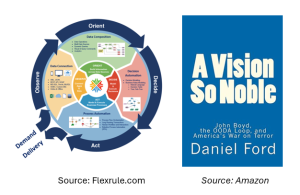
Benefits of using OODA:
- Speed over perfection: It’s better to make a decision and take action quickly than to wait for all the information to be perfect. Speed allows us to outpace your opponent.
- Adaptability: The OODA loop is meant to be flexible and iterative. After we act, we observe again to see the effects of our actions, and then we go through the cycle again. As conditions change, we must adjust our observations, orientation, decisions, and actions.
Where OODA is used:
It’s widely applicable beyond the military and is used in various fields like business, sports, and personal development, and in every area of our lives where speed, agility and adaptability are needed during our decision making process. I would highlight personal decision-making process where we can use OODA to solve problems, navigate complex decisions.
Lean Startup (Build-Measure-Learn)
Lean Startup is a methodology designed for developing businesses and products in a more efficient and validated way. It focuses on reducing product development cycles, measuring progress, and learning quickly to ensure that a business or product meets market needs before fully launching.
Steps of Lean Startup:
- Build: Start by developing a “Minimum Viable Product” (MVP), which is a simplified version of our product with the core features necessary to solve a problem for our target customers.
- Measure: Release the MVP to real customers and gather data on how they use it. This can be done through analytics, user feedback, and behavior tracking.
- Learn: Analyze the data from the MVP to understand whether it meets the target customers’ needs. Based on this learning, we can either pivot (change direction) or persevere (keep improving the product).
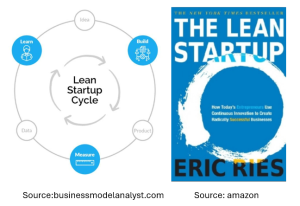
Benefits of using Lean Startup:
- Faster time to market: By focusing on the MVP, we can quickly release a product or service to test the waters without investing too much upfront.
- Cost-effective: It reduces the risk of large financial losses since we’re only building what’s necessary and testing assumptions early.
- Better alignment with customer needs: Continuous feedback allows businesses to iterate on the product and ensure it’s aligned with what the customers actually want.
- Faster learning: We gain insights quickly through real-world use, helping us make data-driven decisions.
Where Lean Startup is used:
The Lean Startup methodology can be applied in any setting where fast, customer-centered innovation is critical: startups, corporate innovation, tech companies, product development teams, nonprofits and social enterprises.
GROW (Goal – Reality – Options – Will)
GROW is a widely-used coaching and problem-solving framework that helps individuals or teams achieve goals by providing a structured approach to thinking through challenges. The model focuses on setting clear objectives, exploring options, and establishing concrete actions.
Steps of GROW:
- G – Goal: This step involves clearly defining the goal we want to achieve. It’s important to make the goal specific, measurable, achievable, relevant, and time-bound (SMART). The goal can be short-term or long-term, but it should be clear and motivating.
- R – Reality: In this step, we assess the current situation. It’s about understanding where we are now in relation to our goal. This includes identifying obstacles, resources available, strengths, weaknesses, and any external factors that might affect our progress.
- O – Options: Here, we brainstorm different options and strategies for overcoming obstacles and achieving the goal. This step is all about exploring different approaches without immediately committing to any one solution. It encourages creative thinking and identifying various pathways forward.
- W – Will: In this final step, we decide on the specific actions we will take to move forward. We break down the options into actionable steps and establish a clear plan with deadlines. This is where commitment and accountability come into play.
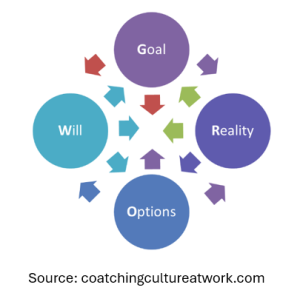
Benefits of using GROW:
- Clarity: The structured approach helps individuals and teams gain clarity about their goals, challenges, and next steps.
- Focus: It keeps the conversation and thought process focused on finding practical solutions and taking actionable steps.
- Increased accountability: By creating a clear action plan in the “Will” phase, individuals or teams are more likely to take responsibility for achieving their goals.
- Empowerment: The framework encourages self-reflection and autonomy, as it emphasizes finding your own solutions and taking ownership of actions.
- Improved decision-making: It helps you systematically consider various options, which leads to more informed and well-thought-out decisions.
- Versatility: GROW can be applied to various types of goals, whether personal, professional, short-term, or long-term.
Where GROW is used:
GROW is a practical and adaptable framework for goal-setting, coaching, and problem-solving across a variety of fields and scenarios, like coaching, leadership development, personal development, team management, education, corporate settings.
PDSA (Plan-Do-Study-Act)
PDSA (Plan-Do-Study-Act) is a framework for continuous improvement that is commonly used in quality management, process improvement, and problem-solving. It helps organizations or teams improve their processes, products, or services by systematically testing and refining changes. PDSA encourages iterative cycles of planning, executing, evaluating, and adjusting to ensure better outcomes over time.
Steps of PDSA:
- Plan: In this phase, we define the problem or area of improvement and develop a plan for testing a solution. This includes setting clear objectives, determining what changes or improvements are necessary, and outlining how success will be measured.
- Do: This step involves implementing the plan on a small scale to test the proposed changes. We carry out the plan, collect data, and observe how the changes impact the system. The “Do” phase is about experimentation—making sure the change works before rolling it out broadly.
- Study: After implementing the changes, we assess the results. This involves analyzing the data we collected during the “Do” phase to understand what worked and what didn’t. We compare the results to our initial goals to determine if the changes lead to improvement and whether they should be scaled or adjusted.
- Act: Based on the findings from the “Study” phase, we decide on the next steps. If the change was successful, we can standardize the solution and implement it on a larger scale. If it wasn’t successful, we adjust the plan and run another cycle to further refine the process.
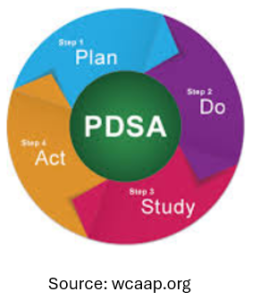
Benefits of using PDSA:
- Continuous improvement: PDSA fosters an ongoing cycle of testing and refining, leading to continuous improvement over time rather than one-time fixes.
- Data-driven decisions: The framework relies on data collection and analysis, ensuring decisions are based on real-world evidence rather than assumptions.
- Reduced risk: By testing changes on a small scale before full implementation, PDSA helps minimize the risk of widespread failure.
- Flexibility: PDSA can be applied to a wide variety of problems or projects, making it versatile in different industries and contexts.
- Empowers teams: PDSA encourages teams to take ownership of their processes, experiment, and adapt based on real-time feedback.
Where PDSA is used:
PDSA is a powerful tool for driving improvement through small, manageable changes, testing hypotheses, and refining solutions over time. It’s used across industries to enhance quality, efficiency, and customer satisfaction. Key areas where PDSA can be used are: manufacturing, healthcare, education, project management, government and non-profit sectors.
Summary
